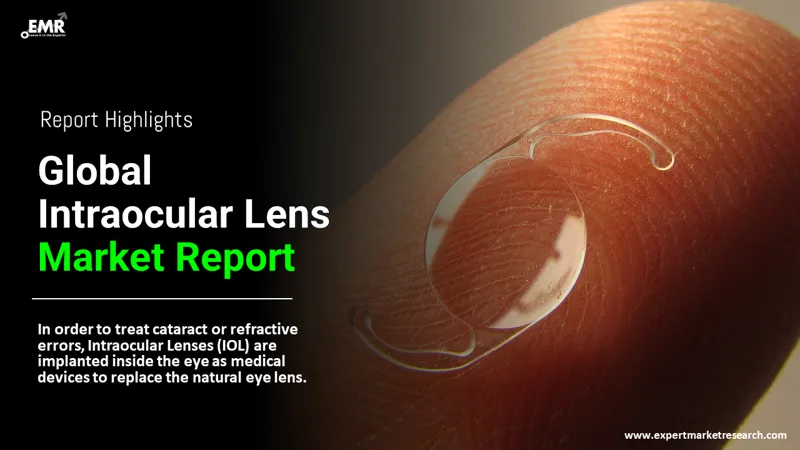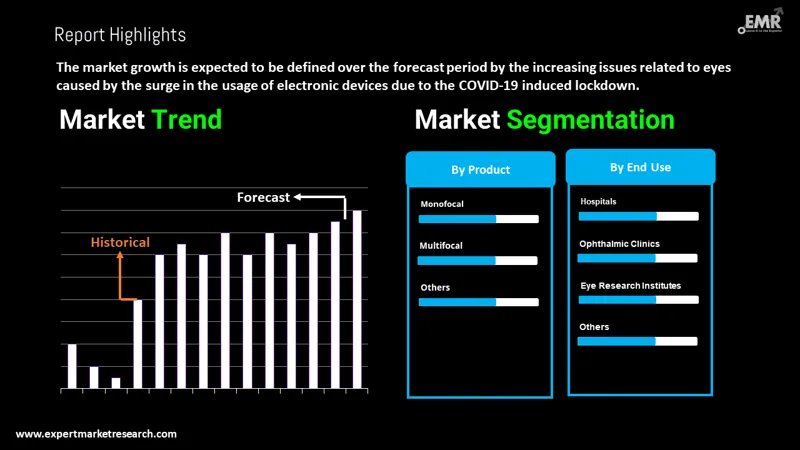
Consumer Insights
Uncover trends and behaviors shaping consumer choices today
Procurement Insights
Optimize your sourcing strategy with key market data
Industry Stats
Stay ahead with the latest trends and market analysis.
The global intraocular lens market value was USD 4.51 Billion in 2025, driven by the increasing prevalence of cataracts and other eye-related disorders across the globe. The market size is anticipated to grow at a CAGR of 5.60% during the forecast period of 2026-2035 to achieve a value of USD 7.78 Billion by 2035.
Base Year
Historical Period
Forecast Period
Compound Annual Growth Rate
5.6%
Value in USD Billion
2026-2035
*this image is indicative*
The demand for the intraocular lens is being driven by the rising cases of computer vision syndrome that is caused by looking at the screen for too long. In addition to this, the industry is accelerated by the growing digitalisation and the increasing use of computers for professional work. Due to the escalating use of computers at almost every workplace or in one’s leisure time, there is a great risk of getting computer vision syndrome without any regard to being old or young.

Read more about this report - REQUEST FREE SAMPLE COPY IN PDF
Recently, there has been a rising demand for technologically advanced premium IOLs, such as multifocal IOLs, accommodating IOL, presbyopia- and astigmatism-correcting intraocular lens (IOL), extended depth of focus (EDoF) IOL. Also, in order to improve the quality of vision and reduce the risk of blindness, the demand for the intraocular lens is increasing. The rising focus of companies to capture emerging countries and gradually shift towards newer technologies are predicted to provide significant growth opportunities for players in this market.

Read more about this report - REQUEST FREE SAMPLE COPY IN PDF
Intraocular lenses (IOL) refer to the medical devices that are implanted inside the eye to replace natural eye lens in order to treat refractive errors or cataract.
Breakup by Product
Breakup by End User
Breakup by Region
The market is propelled by the increasing ophthalmic issues and growing cases of cataracts in the diabetic population. This is caused by various factors, such as the use of electronics for a long period of time, staring at the screen for hours for work or for leisure activities like chatting. Rapid digitalisation and rising use of electronic devices like mobile phones, computers, tablets, and laptops, among others, due to excessively engaging social media platforms, are contributing to a high risk to their vision capacity. The rising use of social media and changing mode of work has facilitated the use of electronic devices, which has affected many irrespective of their age. A large section of people beyond 60 years of age is often very likely to be affected by various kinds of ophthalmic issues that are chronic and demand eye corrections. As a repercussion of this unhealthy trend, there is an increase in the demand for intraocular lens treatment. Since this treatment offers more precise solutions and varied options for physicians, there is certainly an increase in the demand for intraocular lens. Further, the growth in this market can be attributed to the rapid growth of eye disorders, the growing prevalence of eye diseases and diabetes across the globe, technological advancements, and rising government initiatives to treat blindness caused by cataracts.
The report presents a detailed analysis of the following key players in the global intraocular lens market, looking into their capacity, market shares, and latest developments like capacity expansions, plant turnarounds, and mergers and acquisitions:
The comprehensive report looks into macro and micro aspects of the industry. The EMR report gives an in depth insight into the market by providing a SWOT analysis as well as an analysis of Porter’s Five Forces model.




*While we strive to always give you current and accurate information, the numbers depicted on the website are indicative and may differ from the actual numbers in the main report. At Expert Market Research, we aim to bring you the latest insights and trends in the market. Using our analyses and forecasts, stakeholders can understand the market dynamics, navigate challenges, and capitalize on opportunities to make data-driven strategic decisions.*
Get in touch with us for a customized solution tailored to your unique requirements and save upto 35%!
The intraocular lens market was valued at USD 4.51 Billion in 2025.
The market is expected to grow at a CAGR of 5.60% from 2026 to 2035 to reach a value of USD 7.78 Billion by 2035.
The major drivers of the market include rising ophthalmic issues, increasing cataract issues, growing computer vision syndrome, and high demand for technically advanced correcting lens.
The prolonged exposure to electronic devices, the rising geriatric population, the surging prevalence of diabetes, and technological advancements and innovations are the key trends propelling the market growth.
The major regions in the market are North America, Europe, the Asia Pacific, Latin America, and the Middle East and Africa.
The significant products considered in the market report are monofocal, multifocal, toric, and accommodative, among others.
The various end uses of intraocular lens are hospitals, ophthalmic clinics, ambulatory surgery centres, and eye research institutes, among others.
The leading players in this market are Johnson and Johnson Vision Care, Inc., Bausch & Lomb Incorporated, Carl Zeiss Meditec AG, Eyekon Medical, Inc., and HumanOptics AG, among others.
Explore our key highlights of the report and gain a concise overview of key findings, trends, and actionable insights that will empower your strategic decisions.
| REPORT FEATURES | DETAILS |
| Base Year | 2025 |
| Historical Period | 2019-2025 |
| Forecast Period | 2026-2035 |
| Scope of the Report |
Historical and Forecast Trends, Industry Drivers and Constraints, Historical and Forecast Market Analysis by Segment:
|
| Breakup by Product |
|
| Breakup by End User |
|
| Breakup by Region |
|
| Market Dynamics |
|
| Supplier Landscape |
|
| Companies Covered |
|
Datasheet
One User
USD 3,299
USD 2,969
tax inclusive*
Single User License
One User
USD 5,499
USD 4,949
tax inclusive*
Five User License
Five User
USD 6,999
USD 5,949
tax inclusive*
Corporate License
Unlimited Users
USD 8,199
USD 6,969
tax inclusive*
*Please note that the prices mentioned below are starting prices for each bundle type. Kindly contact our team for further details.*
Flash Bundle
Small Business Bundle
Growth Bundle
Enterprise Bundle
*Please note that the prices mentioned below are starting prices for each bundle type. Kindly contact our team for further details.*
Flash Bundle
Number of Reports: 3
20%
tax inclusive*
Small Business Bundle
Number of Reports: 5
25%
tax inclusive*
Growth Bundle
Number of Reports: 8
30%
tax inclusive*
Enterprise Bundle
Number of Reports: 10
35%
tax inclusive*
How To Order

Select License Type
Choose the right license for your needs and access rights.

Click on ‘Buy Now’
Add the report to your cart with one click and proceed to register.

Select Mode of Payment
Choose a payment option for a secure checkout. You will be redirected accordingly.
Gain insights to stay ahead and seize opportunities.

Get insights & trends for a competitive edge.

Track prices with detailed trend reports.

Analyse trade data for supply chain insights.

Leverage cost reports for smart savings

Enhance supply chain with partnerships.

Connect For More Information
Our expert team of analysts will offer full support and resolve any queries regarding the report, before and after the purchase.
Our expert team of analysts will offer full support and resolve any queries regarding the report, before and after the purchase.
We employ meticulous research methods, blending advanced analytics and expert insights to deliver accurate, actionable industry intelligence, staying ahead of competitors.
Our skilled analysts offer unparalleled competitive advantage with detailed insights on current and emerging markets, ensuring your strategic edge.
We offer an in-depth yet simplified presentation of industry insights and analysis to meet your specific requirements effectively.
Share